The Eastern Europe Affordable Resorts Market is estimated to be valued at USD 1012.4 million in 2025 and is projected to reach USD 1498.6 million by 2035, registering a compound annual growth rate (CAGR) of 4.0% over the forecast period.
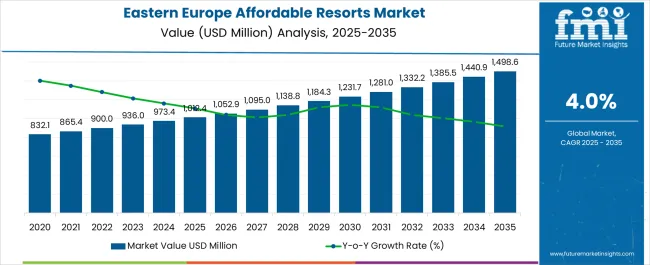
| Metric | Value |
|---|---|
| Eastern Europe Affordable Resorts Market Estimated Value in (2025 E) | USD 1012.4 million |
| Eastern Europe Affordable Resorts Market Forecast Value in (2035 F) | USD 1498.6 million |
| Forecast CAGR (2025 to 2035) | 4.0% |
The Eastern Europe affordable resorts market is witnessing strong traction, supported by increasing interest in budget-friendly travel across culturally rich and geographically diverse destinations. Cost competitiveness relative to Western Europe, combined with improved air and rail connectivity, is drawing higher tourist footfall from both intra-European and international markets.
Enhanced government initiatives focused on tourism infrastructure, coupled with digital marketing campaigns promoting offbeat travel, are enabling lesser-known resort regions to gain visibility. Exchange rate advantages, rising backpacker culture, and shifting preferences toward experiential over luxury travel have made affordable resorts a preferred option.
Continued growth is expected as younger travelers and middle-income groups seek value-oriented stays, supported by dynamic pricing models and mobile-based travel planning. Seasonal travel patterns, multi-country itineraries, and remote work flexibility are further contributing to year-round demand across the region’s affordable resort network.
The market is segmented by Destinations Type, Booking Channel, and Age Group and region. By Destinations Type, the market is divided into Czech Republic, Hungary, Slovakia, Serbia, Romania, and Others. In terms of Booking Channel, the market is classified into Online Booking, Phone Booking, and In Person Booking. Based on Age Group, the market is segmented into 26–35 Years, 15–25 Years, 36–45 Years, 46–55 Years, 56–65 Years, and 66–75 Years. Regionally, the market is classified into North America, Latin America, Western Europe, Eastern Europe, Balkan & Baltic Countries, Russia & Belarus, Central Asia, East Asia, South Asia & Pacific, and the Middle East & Africa.
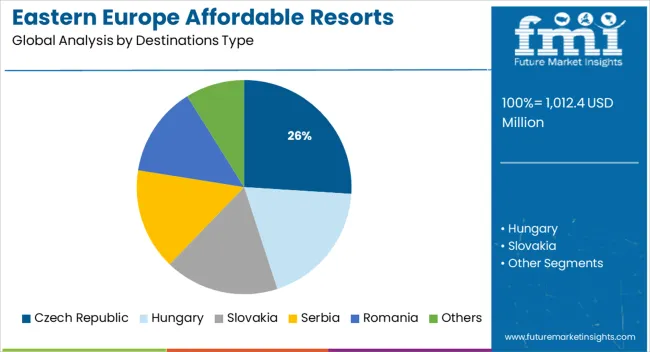
The Czech Republic is projected to account for 26.0% of the total revenue in the Eastern Europe affordable resorts market by 2025, making it the leading destination type. Its dominance is being driven by the availability of well-maintained resorts offering competitive pricing, cultural heritage experiences, and easy access from neighboring EU countries.
High urban connectivity, scenic countryside retreats, and a well-established tourism service sector have strengthened the country's appeal among budget-conscious travelers. Additionally, robust support from national tourism boards for promoting rural and eco-destinations within the country has widened its reach across segments beyond capital-city tourism.
Local hospitality infrastructure, favorable visa policies, and integration with online booking platforms continue to enhance the Czech Republic’s attractiveness as a central affordable resort destination in Eastern Europe.
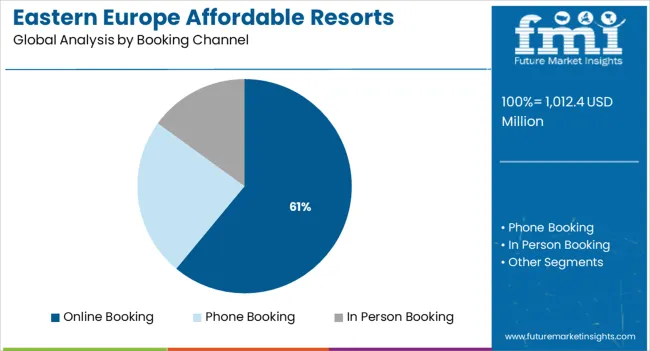
Online booking is expected to contribute 61.0% of total revenue in the Eastern Europe affordable resorts market by 2025, positioning it as the leading booking channel. This growth is being fueled by rising smartphone penetration, increased trust in digital payment systems, and the preference for customized travel planning.
Travelers are increasingly using online platforms for price comparison, last-minute deals, and access to user reviews, all of which influence accommodation choices. Resort operators have adapted by enhancing their online presence and offering direct booking incentives through their own websites or OTAs.
Integration with mobile wallets, loyalty programs, and geo-targeted promotions further supports the momentum behind digital bookings. As convenience, flexibility, and transparency remain key traveler expectations, online booking continues to dominate across all resort tiers and travel demographics.
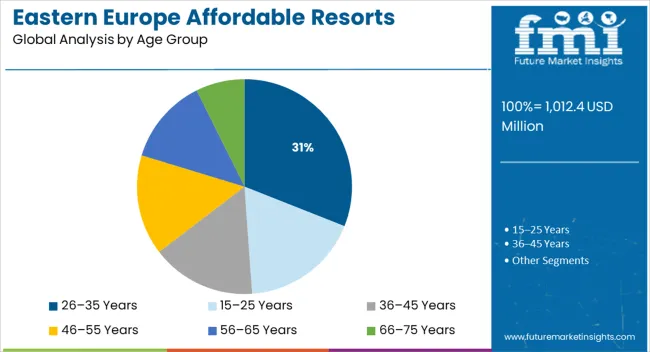
Travelers aged 26–35 years are projected to account for 31.0% of the market share in 2025, making this demographic the primary consumer group in the affordable resorts segment. Their dominance is being shaped by higher mobility, digital-first travel planning habits, and a strong preference for budget-conscious yet enriching travel experiences.
This age group frequently seeks independent, flexible travel supported by online resources and often gravitates toward resort stays that offer a balance of comfort, accessibility, and local authenticity. Social media influence and peer-generated content play a critical role in shaping destination awareness and decision-making patterns.
Additionally, the rise of remote work, gig-based employment, and travel-based lifestyles has expanded their frequency of travel, including off-season and short-notice bookings. Resort operators targeting this demographic are increasingly aligning offerings with wellness, outdoor recreation, and local immersion, supporting further growth in this segment.
Europe is the most visited country by tourists and accounts for the largest tourism market throughout the globe. Europe has a great diversity in its culture, historical heritage, spectacular landscapes, and amazing cuisine which is supplemented by a friendly atmosphere encouraged by the locals throughout Europe. While most of the attention is captured by Western Europe consisting of countries like France, Spain, Italy, etc., Eastern Europe has also started gaining the attention of the tourists who look for a relatively affordable tour and also the tourists who are willing to explore new destinations of Europe by taking the less traveled roads.
Initially, most regions of Eastern Europe were locked to other parts of the world due to the ongoing cold war. However, all the countries included in this part have grown to be fully democratic and are considered to be developed nations of Europe. As a result, these countries are gaining a tremendous amount of tourist attraction and which has laid the foundation for many affordable resorts in this region.
Czech Republic, Hungary, Slovakia, Serbia, and Romania, some of the famous regions in Eastern Europe have shown a huge rise in the number of tourists visiting these places. This trend is expected to continue in the coming years with the addition of more Eastern European nations to the list.
There are many dark destinations in Eastern Europe that interests dark travellers throughout the world because of their linkage with historical events such as the world war, the cold war, etc. The communist pasts of central and eastern European nations fascinate many travellers, especially those from western democracies. The desire of many locals to separate themselves from and forget their painful pasts combines with their want to see, absorb, and experience the vestiges of life behind the “Iron Curtain”.
The demand for economic gain obtained from commercialising communist relics is ironically entangled with the wish of the locals to forget their collectively traumatic history in many eastern European nations like Bulgaria, Romania, Hungary, the Czech Republic, and Poland. This provides an upper hand to the eastern European affordable resorts market by increasing the number of tourists travelling its territory, looking for cheap but cheerful accommodations to balance their encounters with the dark destinations.
Eastern Europe has started to rise as the new travel destination for history enthusiasts who tend to spend less for their accommodation. Tourists are visiting Eastern Europe on high levels. This has started a competition among the top players to attract more number of tourists to their resorts. As a result, these players are coming up with new and exciting offers to interest more number of travellers.
They are providing amazing discounts for offers on longer stays, frequent travellers, early bookings, summer vacations, etc. while they also have offers for focused categories of travellers and age groups which include government and military discounts, senior citizen discounts and student discounts. This has helped in attracting more tourists and enhancing the Eastern European affordable resort market.
There are a lot of activities that a tourist adds to his/her itinerary while planning their tour. Skiing is one of the most enjoyed activities in the European region in the extremely cold span from December to February. Skiing in Western Europe is considered too expensive by most European tourists. However, the resorts in Eastern Europe have come up with package deals that include a few days of skiing to satisfy the desire of skiing tourists at reasonable prices.
These affordable resorts have also hosted many international skiing events which have improved the quality of service through the use of enhanced facilities for skiing. This has proved to captivate tourists with these exciting skiing offers.
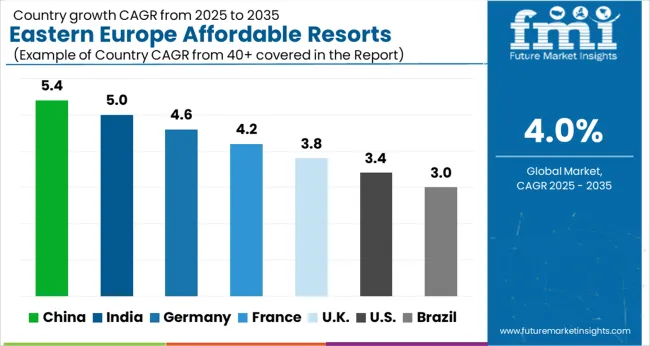
Travelers are unsure about safety while visiting Ukraine and neighboring countries
The conflict between Ukraine and Russia has impacted the Eastern European tourism sector to a great extent. Even nations without a border with Ukraine are being impacted by the crisis. This has caused Krakow, Poland, bookings for the summer of 2025 to drop by 60%. Bookings to Riga in Latvia, and Budapest in Hungary, both declined by 39% and by 45%, respectively.
According to data from the Hungarian Tourism Agency, international visitors to the nation declined by 37% in the initial phase of 2025 compared to 2020. USA citizens are down 65%. It has observed an increase in the numbers and has a view that a 10% decline by year's end will be seen. According to data from its tourist board, Slovakia, which shares its borders with western Ukraine, saw a 49% decline in foreign visitors from 2020 to 2020.
It's interesting to note that tourism is rising in two of the nearby nations. Moldova, which borders Ukraine, welcomed 36,100 non-resident tourists in the first quarter of 2025 compared to 31,000 in 2020 before the pandemic. Even Poland saw a 20% increase in USA visitors despite a 25% decline in overall tourism from February to May 2025.
Romanians are focusing on the development of their wine
The country produces wine very differently and has a very different approach toward winemaking, which should benefit its booming tourism sector. Although there aren't many international visitors, the wine industry is developing nonetheless. Wine production is becoming cleaner, and many wine regions are now prepared to receive visitors.
The fact that producers are emphasizing premium wines made from regional grape types is another positive. The improvement of the nation's wine quality has also been boosted by an infusion of foreign chefs and sommeliers. The country's wine sector may have a bright future if it can get its wines in front of prominent wine experts which is expected to boost the tourism sector in Romania.
Online Booking is More Preferred by Tourists
Online mode of booking is the most preferred booking channel among tourists and is expected to grow in the coming times. Tourists looking for affordable resorts often opt for online booking as they provide a variety of offers and discounts on several bases such as pre-booking, group bookings, etc. Also, the internet is being used to a great extent in recent times which provides the convenience of booking to travelers.
The popularity among Youngsters Will Remain High
Travelers from the age group of 26-35 are more likely to opt for the affordable resorts in Europe as this group is interested in exploring and taking unexplored paths without taking a massive hit to their pockets. While the activities like skiing are something that interests and is practiced majorly by youngsters.
Group Tour Type is More Preferred by Tourists
The tour providers or the top players in Eastern European resorts provide exciting offers on group bookings. While tourists wanting affordable resorts are often looking for offers and discounts. As a result, tourists prefer traveling with a tour group to take advantage of the added benefits.

The top players in the affordable resort market in Eastern Europe are coming up with new strategies and improving their offerings by providing great deals. They also include various activities such as skiing in their packages to attract more and more tourists.
For instance:
Atrium Palace is offering package deals that are transferable in case of changes in the dates of the tourists. While they have also included rental cars in some of the packages for the convenience of travelers while exploring Eastern Europe.
| Attribute | Details |
|---|---|
| Forecast Period | 2025 to 2035 |
| Historical Data Available for | 2020 to 2024 |
| Market Analysis | USD Million for Value |
| Key Region Covered | Eastern Europe |
| Key Countries Covered | Czech Republic, Poland, Hungary, Slovakia, Romania, Bulgaria, Moldova, Ukraine, Belarus, and Russia |
| Key Segments Covered | Destinations, Booking Channel, Tourist Type, Tour Type, Age Group, and Region. |
| Key Companies Profiled | Accor; Best Western; Intercontinental Hotels & Resorts; Groupe Du Louvre; Carlson Rezidor Hotel Group; NH Hotels; Atrium Palace; Concorde Deluxe Resort; Village Heights Resort; Seven Seas Hotel; Michelangelo Resort; Aurora Resort |
| Report Coverage | Market Forecast, Company Share Analysis, Competition Intelligence, Drivers, Restraints, Opportunities and Threats Analysis, Market Dynamics and Challenges, and Strategic Growth Initiatives |
| Customization & Pricing | Available upon Request |
The global eastern europe affordable resorts market is estimated to be valued at USD 1,012.4 million in 2025.
The market size for the eastern europe affordable resorts market is projected to reach USD 1,498.6 million by 2035.
The eastern europe affordable resorts market is expected to grow at a 4.0% CAGR between 2025 and 2035.
The key product types in eastern europe affordable resorts market are czech republic, hungary, slovakia, serbia, romania and others.
In terms of booking channel, online booking segment to command 61.0% share in the eastern europe affordable resorts market in 2025.






Full Research Suite comprises of:
Market outlook & trends analysis
Interviews & case studies
Strategic recommendations
Vendor profiles & capabilities analysis
5-year forecasts
8 regions and 60+ country-level data splits
Market segment data splits
12 months of continuous data updates
DELIVERED AS:
PDF EXCEL ONLINE
Europe Radiotherapy Patient Positioning Market Size and Share Forecast Outlook 2025 to 2035
Europe Polyvinyl Alcohol Industry Analysis Size and Share Forecast Outlook 2025 to 2035
Europe Cruise Market Forecast and Outlook 2025 to 2035
Europe Massage Therapy Service Market Size and Share Forecast Outlook 2025 to 2035
Europe Cement Market Analysis Size and Share Forecast Outlook 2025 to 2035
European Union Tourism Industry Size and Share Forecast Outlook 2025 to 2035
Europe Injection Molding Machines Market Size and Share Forecast Outlook 2025 to 2035
Europe Injection Moulders Market Size and Share Forecast Outlook 2025 to 2035
Europe and MENA Generic Oncology Drug Market Size and Share Forecast Outlook 2025 to 2035
Europe Masking Tapes Market Size and Share Forecast Outlook 2025 to 2035
Europe Liners Market Size and Share Forecast Outlook 2025 to 2035
Europe Dermal Fillers Market Size and Share Forecast Outlook 2025 to 2035
Europe Trolley Bus Market Size and Share Forecast Outlook 2025 to 2035
Europe Protease Market Size and Share Forecast Outlook 2025 to 2035
Europe Luxury Packaging Market Size and Share Forecast Outlook 2025 to 2035
Europe & USA Consumer Electronics Packaging Market Size and Share Forecast Outlook 2025 to 2035
Europe Plant-Based Meal Kit Market Size and Share Forecast Outlook 2025 to 2035
Europe Temperature Controlled Packaging Solutions Market Size and Share Forecast Outlook 2025 to 2035
Europe Rubber Derived Unrefined Pyrolysis Oil Market Size and Share Forecast Outlook 2025 to 2035
Europe Pet Food Market Analysis by Nature, Product Type, Source, Pet Type, Packaging, Distribution Channel, and Country - Growth, Trends, and Forecast through 2025 to 2035

Thank you!
You will receive an email from our Business Development Manager. Please be sure to check your SPAM/JUNK folder too.
Chat With
MaRIA